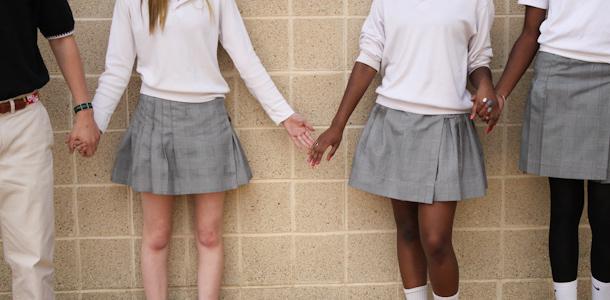With the International Student Program in its second year and 36 African American students among what used to be an all-white population in 1964, as well as other changes to JC’s demographics, Vice Principal for Academics Gary Scholl believes the school has “come a long way.”
The administration has set a target for participants in the International Student Program to make up eight to ten percent of the student population. The administration has publicly stated its goal to better educate the student body on acceptance of all forms of diversity.
Despite having what Scholl considers a “diverse” student body, he thinks that “there is still a need to develop recruiting plans for maintaining a diverse student body. There are no specifics in place right now. We have to examine our recruiting efforts.”
“The administration under the leadership of [President Richard] O’Hara and [Principle Madelyn] Ball under the direction of our Board of Trustees work with our admissions director [Kim Brueggemann] and her staff [to ensure that the student body becomes diverse year after year],” Dean of Students Thomas Vierheller said.
As for what will be done exactly in the future, the plans are still “in the process” of being made, according to Scholl.
“JC is a community of human beings. They aren’t perfect, but the majority of all ethnicities are tolerant and accepting and understanding of cultural, ethnic differences … There are students who aren’t as open, but it’s our job to address that through our academic programs and extracurricular activities to create harmony and understanding,” Scholl said.
“The expectation is there, simply to keep diversity in the mix, rather than the ‘goal.’ There is no quota by race, religion, or other standard. I challenge our students to truly embrace the students from other countries and cultures. They will be better people for doing so,” Vierheller said.
Junior William Du, a Chinese students, agrees with Scholl’s views on the community. “Sometimes I hang out with different races. I think it’s hard to find racists at JC,” he said.
In a survey conducted by The Patriot, 52 percent of students surveyed said that they eat lunch with students of another race a few time a week or more (see below). On the other side, 23 percent of students answered that they eat never eat lunch with a student of a different race. The survey was sent to the student body on April 24. The Patriot received 200 responses.
Scholl recognizes that there is segregation in the cafeteria between some of the ethnicities, but he doesn’t think it is “a whole lot different than in other schools. You see the same thing.”
“I sit with multiple kids of different races … However, most of the different races have their own table and the students pretty much sit wherever,” sophomore Matt Frey, a white student,said.
According to Scholl, the school is looking to expand how “we are looking at other aspects of the school for teacher training in areas to make JC more welcoming to the students of all ethnicities.”
The school’s racial makeup has also changed in terms of the number of African Americans enrolled. “In the last four years, our African American population has increased significantly at JC. Our goal is to ensure that we continue to attract African American students from Harford County,” Scholl said.
Senior Kiana Wright, an African American student, believes that JC has done a “great job at getting diversity, especially compared to other Catholic schools. My sister went to a school with all white teachers and two black people in her graduating class of 170 students … I especially like that JC has students from different countries. That was such a great experience and going into college, I’m one of the only people who has met someone from a different country.”
“I don’t have proof of this, but it seems we’ve reached a level of African Americans that makes JC a safe place to be for African Americans. They see people that look like themselves and that used to not be the case,” Scholl said.
“I’ve never been targeted. Whenever I experience racism it is from a friend or acquaintance who is trying to be funny, but it’s actually ignorant. It’s never a direct attack, just an indirect rude comment,” Wright said.
“The key to any kind of diversity is respecting other people, educating others, and appreciating the fact that everyone brings something to table, not just one person. If we don’t have all of it we are lacking,” Direction of Guidance Carol Heflin said.
In Scholl’s opinion, the community “has come a long way in the acceptance of differences, cultural and ethnic differences.”
Emily Clarke is the Print Chief for The Patriot and jcpatriot.com.



